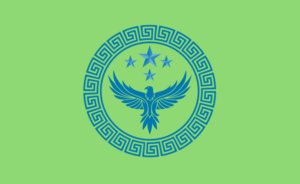Military of Lothia
| Military of Lothia | |
|---|---|
| Aeterna Militarii Lothiae | |
 Shield of the Eternal Military | |
 Flag of the Eternal Military | |
| Motto | Ab Antiquo (From the Ancient) |
| Founded | 2505 BCE |
| Current form | 1951 CE |
| Headquarters | Tergeste, Arcis Ruburm |
| Leadership | |
| Imperator of Lothia | Aulus Ferox |
| Minister of Defense | Tutus Hesychius |
| Chief of the General Staff | Primus Valens |
| Personnel | |
| Military age | 20 for compulsory male service, 18 for volunteer male service |
| Conscription | 20–34 years of age (males only) |
| Available for military service | 33,116,044, age 15–49 |
| Fit for military service | 28,103,233, age 15–49 |
| Reaching military age annually | 4,183,800 |
| Active personnel | 6,215,231 |
| Reserve personnel | 9,031,890 |
| Expenditure | |
| Budget | $840 billion |
| Percent of GDP | 4.0% |
| Industry | |
| Domestic suppliers | Invictus, Navalia Lothiae |
| Foreign suppliers | Royal Marquesan Exports (Marquesan) |
The Military of Lothia, also known as the Eternal Military of Lothia (Lothic: Aeternum Militarii Lothiae) is the unified armed forces of the High Order of Lothia. It consists of the Aeternum Aer Potentia (Air Force), Aeternum Exercitus (Army) and the Aeternum Navalis (Navy). The Imperator of Lothia is the Commander-in-Chief of the military; he receives counsel from the Minister of Defense and the General Staff of the Eternal Military on matters of national defense and strategic options. Conscription is enforced on all males between the ages of 20 and 34 for four years.
The Lothic armed forces trace their origins back to the rise of the Legionem Primam in 2505 BCE, when soldiers from the city-states of Tergeste, Canatha and Carodelphia formed a professional army to attack and subsume the city-state of Vicus Salduba. This professional army would come to swear fealty to the Lothic Republic and defend the burgeoning young democracy from extant threats. The moniker Eternal Army became the official sobriquet in 2111 BCE under the governance of the Republic. When the Republic fell in 105 CE, the military apparatus shifted its allegiance to Agrippa of Gades, who would go on to become the first Imperator of Lothia. The military's importance in Lothic culture grew during the High Order age of the country, with military service becoming mandatory for all males born between the ages of fifteen and twenty (later bumped up to its modern age limits in 1951). The country allied itself with Marquesan around the turn of the twentieth century and would participate in the Great War on the side of the Marquesan League. The ultimate defeat of the Marquesan League in the Hiakemira Campaign would mark a major turning point in the military's efforts to modernize and reorganize its structure.
Since 1951 and the end of the Great War, the Lothic military structure has remaind fairly stable, with the leadership of the Imperator backed by the General Staff. THe country retreated into a period of isolationism following the conflict, though it maintained its heavy reliance on Royal Marquesan Exports to build out its military infrastructure. A push in reent years to modernize its military industrial complex has led to the development of a domestic arms manufacturing industry, led by companies like Invictus. Lothic troops are known for their Bellum Cornu, or war horns that they carry into battle as well as their intense military discipline and bravery in combat. International watchdog organizations have cited the Eternal Military for its cruel training tactics.